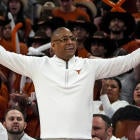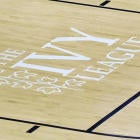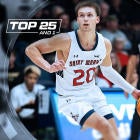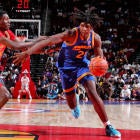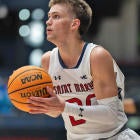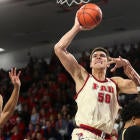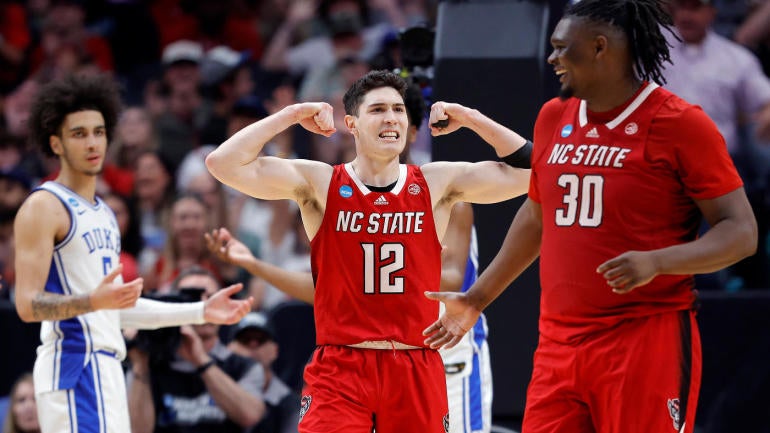
After two chaotic weekends and four memorable rounds, we have reached the end of the road for the 2024 NCAA Tournament. Of the four teams left in contention for this season's national championship, two -- UConn and Purdue -- have been the class of the sport throughout the season and now have a chance to finish strong.
A title for either team would be significant: Either the Huskies become the first reigning champ to repeat since Florida (2006, '07) and complete one of the most dominant two-year tournament runs in history, or Purdue finishes the redemption tour after the crushing disappointment of losing to No. 16 seed Fairleigh Dickenson in last year's first round.
Standing in the way are two teams with their own historical-driven motivations. Alabama has never been to the Final Four, and NC State is back for the first time since winning it all in 1983 with Jim Valvano and the Cardiac Pack. But while all the echoes of history, regular-season records and pre-Final Four form play a role in setting the stage, this is ultimately a championship that will be decided by players and the coaches -- or, more specifically, the outcomes of three games between college basketball teams on the game's biggest stage.
So what about the players, strengths, weaknesses and what to expect from all four teams when they hit the floor on Saturday night? We've got that, and more, covered for you below in our team-by-team breakdowns to get you ready for the semifinals of the NCAA Tournament, where it will be No. 1 seed Purdue vs. No. 11 seed NC State followed by No. 1 seed UConn vs. No. 4 seed Alabama on Saturday night in Glendale, Arizona.
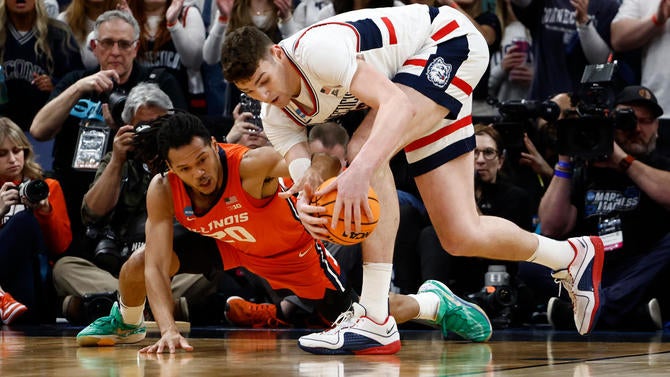
(1) UConn Huskies
No team in the 2024 NCAA Tournament has felt more invincible than UConn, which extended the NCAA Tournament record for consecutive double-digit wins to 10 after its 25-point runaway against the Big Ten Tournament champions, Illinois. Even though this is a different group than a year ago, the level of dominance remains the same with an average margin of victory of 27.8 points per game in the four wins that propelled the reigning champs back to the Final Four. This is a different team, for sure, but it's the same program that has dominated nonconference competition throughout the last two college basketball seasons. For as well-rounded as they appear, there aren't a lot of obvious ways to find an advantage against the Huskies.
While Purdue has absolutely been UConn's equal in terms of regular-season success over the last two seasons, its absence of success in the Big Dance has shaped the conversation that this Final Four is the Huskies' to lose; basically, the only way UConn does not cut down the nets for the second straight season is an aberration, anomaly or other set of unusual circumstances outside the realistic realm of possibilities. Such a declaration is somewhat disrespectful to the rest of the Final Four participants, but absolutely fitting from the perspective of how thoroughly UConn has been able to dispatch its competition over the course of 40 minutes so far in this tournament.
- Record: 35-3
- Final Four appearances: 7 (1999, 2004, 2009, 2011, 2014, 2023, 2024)
- NCAA titles: 5 (1999, 2004, 2011, 2014, 2023)
- NCAA Tournament path: First round — Def. No. 16 seed Stetson 91-52; Second round — Def. No. 9 seed Northwestern 75-58; Sweet 16 — Def. No. 5 seed San Diego State 82-52; Elite Eight — Def. No. 3 seed Illinois 77-52 to win East Regional
- Coach: Dan Hurley is the favorite to win the CBS Sports Coach of the Year for many reasons. Among them was the ability to maintain a national-championship standard while losing three of his top six scorers from the 2023 title team by hitting on new additions Cam Spencer from the transfer portal and true freshman Stephon Castle. Winning at the highest level in the modern era requires that balance of developing your roster while simultaneously evaluating the prospects that could be the missing piece in the year ahead. Tristen Newton and Donovan Clingan have all successfully grown into bigger roles, along with the rest of the rotation that now gets to see more playing time even with some new faces in the mix. Hurley has done both player development and newcomer work at the same time, and when you combine that with maintaining a culture that appears averse to complacency, it's hard to find a tougher coach to beat on this stage.
- Best Player: There is certainly an argument for listing Clingan here -- the 7-foot-2 sophomore has been dominant in this tournament run -- but if UConn is going to win the final two games of this campaign, it will need steady play from Tristen Newton, its First Team All-American guard. Newton is not always the team's primary offensive option as a scorer, but he has a well-rounded game for a primary ball-handler and averages 15.0 points, 6.7 rebounds and 6.1 assists on the season. The Huskies haven't been caught in a close game late yet in this tournament, but if they do in the Final Four, it will be Newton getting the call to step up and get the offense rolling.
- Strengths: UConn's length, athleticism and versatility make life extremely difficult on both ends of the floor for most college basketball teams. Even when met with similarly athletic opposition, the Huskies are able to rise up thanks to the team's connectivity on offense and defense. Offensively, their motion sets constantly test the opponent and exploit any matchup weaknesses. Defensively, they have the length to be disruptive on the perimeter and funnel all the action right to their 7-foot-2 stud center Clingan, who is one of the best shot blockers and rim protectors in the country.
- Weaknesses: It's hard to identify weaknesses for a team that's only lost three times all season and won every single NCAA Tournament game by double digits, but the through line across their defeats has been poor shooting from beyond the arc. UConn's 35.8% 3-point shooting percentage as a team currently rates No. 69 nationally, which is adequate but does sit outside the top 20 of the 68 teams who made the 2024 NCAA Tournament.
- Key number: While we've been pointing to the NCAA Tournament record of 10 straight double-digit wins, even that qualifier does not do UConn's dominance justice. Since the start of last year's NCAA Tournament, the Huskies have a margin of victory of +23.1 points per game, which is currently just ahead of 1967-68 UCLA (+22.5) for the best margin over a two-year span all-time. This is a program that trailed for just 5:50 of 320 total minutes since the 2023 Sweet 16, and it has not trailed in the second half of its last eight NCAA Tournament games.
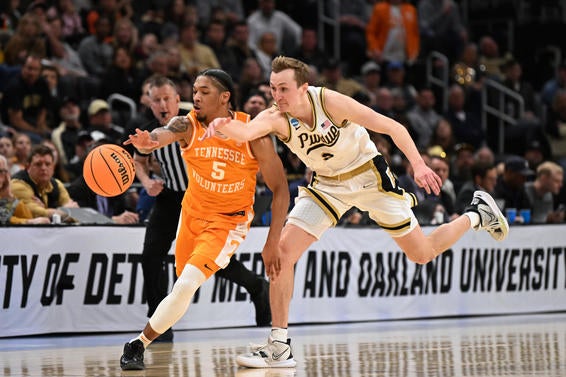
(1) Purdue Boilermakers
The Boilermakers have been locked in since the start of the season, peeling off a school-record 33 wins and winning the outright Big Ten regular-season title for the second year in a row. Purdue's dominance was so thorough and routine, it was perhaps even a little overlooked and taken for granted. This group led the Big Ten in field goal percentage (49.1%), 3-point percentage (40.6%) and assists per game (18.9), while also rating as one of the best rebounding teams in the country. Obviously, the key to unlocking their success is player of the year frontrunner Zach Edey, who is set to become the first back-to-back NPOY winner since Ralph Sampson (1981-83) and has seemingly leveled up his game in moments of raised stakes. Edey's 40-point, 16-rebound performance in the Midwest Regional final against Tennessee was the stuff of legends; he became just the fourth player in the past 60 yards with 40-plus points and 15-plus rebounds in an NCAA Tournament game, joining Bo Kimble (1990), Elvin Hayes (1968) and Bill Bradley (1965).
Getting to the Final Four was a big emotional lift, too. Purdue had not done so since 1980 including the last 19 seasons with Matt Painter as the coach despite consistent regular-season success and nearly annual NCAA Tournament appearances. But crushing the narrative that it can't get over the hump (and doing so one year after losing to a No. 16 seed) does not mean the job is done. Given the outlook for the Final Four, the players and coaches on this year's team are quite aware of their chance to make it to the top of the mountain. Virginia's turnaround from losing to a No. 16 seed to winning it all the next year is an easy reference for fans; however, inside Purdue's program, it's the dominance shown along the way that makes a national championship seem well within reach.
- Record: 33-4
- Final Four appearances: 3 (1969, 1980, 2024)
- NCAA titles: None
- NCAA Tournament path: First round — Def. No. 16 seed Grambling State 78-50; Second round — Def. No. 8 seed Utah State 106-67; Sweet 16 — Def. No. 5 seed Gonzaga 80-68; Elite Eight — Def. No. 2 seed Tennessee 72-66 to win Midwest Regional
- Coach: No longer the answer for "best coach not to make a Final Four," Matt Painter deserves every bit of adulation he'll receive this week while he prepares for the national semifinal. Painter has made all but three NCAA Tournaments since taking over prior to the 2004-05 season, but that consistency had not been celebrated recently with each of the last three tournament appearances resulting in an upset loss to a double-digit seed. Painter is known as a sharp basketball mind with a deep playbook, and this year he's helped the Boilermakers elevate their offense with largely the same pieces from a year ago. Those year-over-year improvements are why there's less doubting Purdue, the team with the next-best odds to win it all, as we head into the Final Four.
- Best Player: The historical company that Zach Edey keeps is kind of outrageous. Edey's the first Division I player since Larry Bird in 1979 to notch 900 points and 450 rebounds in a season (at 926 and 452, respectively). Dating back to last year, Edey's 1,683 points and 890 rebounds make him the first player since UNLV's Larry Johnson to hit the 1,600-800 mark in those categories over a two-year span. Want to talk about just this tournament run individually? He's just the fourth player in the last 70 years to average 30 PPG and 15 RPG through four games in the tournament, joining Elvin Hayes, Jerry West and Wilt Chamberlain. Simply put, this is one of the most special college basketball players of all time putting together an all-time performance in pursuit of a championship. It doesn't get much better than that.
- Strengths: Purdue is one of the best half-court offensive teams in the country, with Edey commanding a ton of attention in the post and four capable 3-point shooters on the perimeter. The Boilermakers don't rely exclusively on the 3-pointer for their offense since Edey can often do much of the damage himself inside or at the free-throw line. Rather, the threat of the deep ball, and the consistency with which Purdue's shooters can knock down open shots, makes them one of the hardest teams in the country to guard in the half-court setting.
- Weaknesses: Like UConn, it's tough to find obvious weaknesses with teams that win 30-plus games, but turnovers have been a tell for when things might be going south for Purdue, which doesn't tend to force a lot of turnovers on defense. When Braden Smith and the rest of the Boilermakers backcourt are not effectively taking care of the ball, it leads to easy opportunities on the other end that can help an opponent keep pace with the elite offense. Teams will sometimes try to push the pace anyway to get opportunities at the rim before Edey can get set on defense, so turnovers in the backcourt only help the efforts of the opposition.
- Key number: The biggest change from 2023 to 2024 for Purdue has been the 3-point shooting, which currently ranks second nationally at 40.6% and, depending on how things go in the Final Four, could finish first (Kentucky's 40.9% is No. 1). Last season, a rotation that was largely the same ranked No. 288 in Division I at 32.2%. That jump may only equate to 5.2 points per game given their 3-point rate (20.4 attempts per game), but those five points are a way to win at the margins, and the threat of the 3-point shot changes how teams defend Edey.
(4) Alabama Crimson Tide
One read of Alabama's first-ever appearance in the Final Four is that it celebrates the rarity of the Crimson Tide's deep NCAA Tournament run. This program had but one Elite Eight appearance prior to this year, and before Nate Oats' arrival, the only Alabama coach with multiple Sweet 16 appearances was Wimp Sanderson. But there's also a look at Alabama's Final Four debut that acknowledges a breakthrough for a program that, under Oats, has been knocking at the door of the game's biggest stage. Alabama has made the NCAA Tournament in four of the five years with Oats at the helm, now reaching the Sweet 16 in three of those four tournament runs. Last year, the Tide were not just named a No. 1 seed for the first time in program history, but the No. 1 overall seed in the entire field, making last year's Sweet 16 exit a disappointment.
This year's group was not as heralded in the regular season, though its potential was always identified thanks to one of the best offensive ratings in the country. The style has largely remained the same — play fast, shoot 3-pointers — but the pieces in the rotation and certainly the roles have changed. Defensive issues may have led to double-digit losses prior to the tournament and a No. 4 seed, but what this group has found is enough defense in the right spots to propel the team to victory. Perhaps Alabama's Final Four appearance sets a new standard for the program.
- Record: 25-11
- Final Four appearances: 1 (2024)
- NCAA titles: None
- NCAA Tournament path: First round — Def. No. 13 seed Charleston 109-96; Second round — Def. No. 12 seed Grand Canyon 72-61; Sweet 16 — Def. No. 1 seed North Carolina 89-87; Elite Eight — Def. No. 6 seed Clemson 89-82 to win West Regional
- Coach: A former assistant coach under Bobby Hurley at Buffalo, Nate Oats has been a consistent winner ever since he ascended to the head job with the Bulls. He's led his team to seven-of-eight NCAA Tournaments (three with Buffalo, four with Alabama) and earned coach of the year honors in his conference three times, twice in the MAC and once in the SEC in 2021. Oats landed on Hurley's radar as a coach on the rise during an 11-year run at Romulus High School in Michigan, and those lower-level roots shine through with the ability to fit a variety of players and playing styles into his system to achieve that consistency of winning.
- Best Player: On pace for one of the highest-scoring seasons for an Alabama player since 1979 with 21.5 points per game, Mark Sears is an elite shooter and dynamic scoring guard who has answered the call for key buckets throughout the Crimson Tide's tournament run. He's one of two players in the country to average at least 20 points per game with 50% shooting from the field (50.4%) and 40% shooting from three (43.4%). While Grant Nelson and Jarin Stevenson were breakout stars from the second weekend, any Final Four success is likely going to require a strong showing from Sears.
- Strengths: Playing fast and shooting a lot of 3-pointers is a style choice, but when you are excellent at making those attempts it becomes a strength and identity. Alabama is first among all Division I teams in scoring at 90.6 points per game, and the Tide's 11.2 made 3-point field goals per game is second only to North Florida (12.0). They've had 10 games with at 100 or more points this season, the most for an SEC team since LSU in 1990. Alabama is also the first Division I team since Duke in 2001 to hit at least 400 3-pointers and 600 free throws in a season.
- Weaknesses: By creating all those extra possessions in a game with their pace, the Tide are not as efficient getting stops on the defensive end. Alabama gave up the sixth-most points per game (81.1) of any team in Division I this season, the second-most by an NCAA Tournament team in the past 25 years. When you factor out some of the stronger defensive performances against lesser opponents early, the averages get worse. In the past 11 games, Alabama is giving up nearly 91 points per contest.
Key number: Of the 359 points that Alabama has scored in this NCAA Tournament, 282 of them have come on made 3-pointers or points in the paint. That means 78.5% of Alabama's scoring is done from behind the arc or at the rim, with the rest coming from the free-throw line (69 points) and some rare mid-range jumpers (8 points). The challenge for Alabama will be maintaining the same success rate on those attempts against a UConn team that has perimeter length on defense and one of the best rim protectors in the game. However, Oats and his staff have to like how Alabama has been able to get to its game even against the likes of North Carolina and Clemson.
(11) NC State Wolfpack
There's something special going on with this NC State team. How else can you explain losing 10 of your final 14 regular-season games before going on an all-time postseason heater, reaching program heights not seen in a generation? At first, NC State was celebrated for five wins in five days, becoming the only other program since 2011 UConn to achieve that feat, and in doing so claimed the ACC's automatic bid to the NCAA Tournament.
That might have been enough, you'd think, but a game-by-game approach has allowed the run to continue to seven wins in 12 days. In all, the Wolfpack have nine wins across 19 days, from the first round of the ACC Tournament to the Elite Eight win against Duke. Seven of those nine were against NCAA Tournament teams and four of were against top-four seeds in the field. Two have been against Duke.
Nine national championships have been won by Tobacco Road rivals since the Wolfpack were last in the Final Four, so beating North Carolina to make the NCAA Tournament and Duke in the Elite Eight makes this run even sweeter for those Wolfpack fans who've waited for this moment.
In advancing to the national semifinals, NC State joins a six-way tie for the lowest seed to make a Final Four since 1979. Now, they're looking to accomplish what none of the previous five teams were able to do: advance to the national championship game. NC State may be a program with national championship trophies that Purdue and Alabama can't claim, but given their fairytale journey to reaching this stage, the Wolfpack are the great Cinderella story of the 2024 NCAA Tournament.
- Record: 26-14
- Final Four appearances: 4 (1950, 1974, 1983, 2024)
- NCAA titles: 2 (1974, 1983)
- NCAA Tournament path: First round — Def. No. 6 seed Texas Tech 80-67; Second round — Def. No. 14 seed Oakland 79-73 (OT); Sweet 16 — Def. No. 2 seed Marquette 67-58; Elite Eight — Def. No. 4 seed Duke 76-64 to win South Regional
- Coach: Few coaches have flipped their fortunes in a month quite like Kevin Keatts, who was 0-4 in NCAA Tournament games prior to this run and had just two tournament appearances since taking over prior to the 2017-18 season. Now, Keatts has an ACC Tournament title, a Final Four appearance — and all of the contractual bonuses that come with such accomplishments — and a team that's playing with supreme confidence at the right time. He's gotten the Wolfpack to buy in on defending at a high level, and the improvements on that end have been key to limiting opponents with high-end offensive ceilings. Keatts himself was in the Final Four prior as an assistant for Rick Pitino at Louisville during a tenure that included the 2013 national championship.
- Best Player: Though not the team's leading scorer on the season, the Most Outstanding Player of the South Regional, DJ Burns Jr., has become one of the stars of this tournament and the face of NC State's run. Burns averaged just north of 12 points per game in the regular season but is up to 18.3 points per game at 67.4% from the field in the tournament. The last player to have points and field goal averages like that heading into a Final Four was Arkansas' Corliss Williamson back in the Razorbacks' title run of 1994. Similarly, Burns has been a dominant and game-changing force in the paint. His 29-point performance against Duke in the Elite Eight was the most in NC State history in an Elite Eight or Final Four game, one more than the 28 points scored by both David Thompson and Tom Bruleson in the 1974 Final Four.
- Strengths: NC State does an excellent job of using every inch of the court, and the Wolfpack have the right pieces on this roster to execute on both ends of the floor. The rotation is largely made up of players who started their college careers elsewhere, but Keatts has molded them into a group that spaces the floor well around Burns inside and does a strong job of getting out in transition to get easy buckets. The Wolfpack also use a good bit of full-court pressure, which doesn't always force turnovers but certainly keeps opponents from getting into a rhythm on offense.
- Weaknesses: If you isolate NC State's performances in this NCAA Tournament from the rest of the sample, it's difficult to find obvious weaknesses outside of perhaps some matchup edges they lack against other Final Four teams. If the Wolfpack were to revert to some of their regular-season habits, this is a team that has lacked consistency at times shooting 3-pointers and could face some depth issues if faced with injuries or foul trouble.
- Key number: NC State's improved defense is a huge piece in their tournament success, and it's been elite here in the postseason. The Wolfpack have held each of their last six opponents below 40% shooting from the field, and their field goal defense since the start of the ACC Tournament (nine games) is right at 40%. In that time of strong defense, they've faced Duke, North Carolina, a hot-shooting Oakland, Marquette and Duke again, so it's definitely possible they could maintain that form in Glendale.













